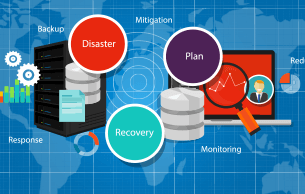It’s not always possible to avoid disaster and the increasingly chaotic world we find ourselves in today is making their frequency (whether economic, political, environmental, etc.) ever more probable. A solid and tested disaster recovery strategy is a must for any business that wants to minimise disruption and loss of profit. Below are some of the bets takeaways to consider when it comes to your business and disaster recovery.
1) Consider the threats
In the past when talking about disaster and disruption, businesses were primarily concerned with displacement. Floods, fires, hurricanes – all could cause a high enough level of disruption to displace employees from the business building, shutting down facilities and the ability to complete tasks. This still happens, especially with the increased frequency of extreme weather events. Businesses still need to consider offsite recovery procedures in their disaster recovery plans. However, another, potentially bigger threat looms close: data loss.
2) Upgrades can derail disaster recovery
You might have what you think is an airtight disaster recovery plan in place, it’s carefully considered, and you test it regularly too. Basically, you’re expecting the unexpected. Think of the last instance your office upgraded its hardware or software, made changes to storage, production, and just about anything else. A disaster recovery plan must be a dynamic document that evolves with every move the business makes if it’s to be valid in all situations, at all times. Be vigilant of how changes might affect your disaster recovery strategy, perhaps appointing a dedicated member of staff to make amends when needed or getting experts, like Sungard AS, to handle it for you.
3) Back up your data
Once upon a time, businesses backed up their data on tapes. Data was copied onto physical tape, and they were then stored offsite in a safe location. If a data centre experienced disruption, tapes would be driven to the business site, and recovery would begin. Today, there’s just so much more data to deal with and a better solution: the cloud. Backing up data to the cloud is an essential part of disaster recovery as storage replication across a dedicated network ensures recovery. It’s also a cost-effective and scalable solution that tends to suit most businesses.
4) Recovery isn’t straightforward
Creating and implementing recovery plans isn’t an easy task. Consider that one company can have multiple systems and computers with processing disparity and the complexity of a recovery plan begins to emerge, creating the need for various recovery systems. Care must be taken when integrating multiple systems and processes into recovery to ensure comprehensive coverage of disaster-prone elements.
5) RTO: recovery time objective
An essential question for any recovery plan is ‘How long can you be down before you must be up and running again?’ Answering this question is difficult as it hinges on things like industry, budgets, business size, and much more. Fully online businesses will have a lower tolerance of downtime compared to manufacturing companies that have an in-built buffer which allows for work continuity. Every business needs to take their RTO into account, implementing precautions and testing the recovery plan to minimise disruptions beyond the RTO.
Businesses need to remain agile in the face of disruption, anticipating and adapting to evolving threats before they’re able to cause damage. A vital thing to remember is that any disaster recovery plan must be tested and updated regularly; it should be thought of as a living and breathing heart of the business safety strategy, and not a one-off exercise









